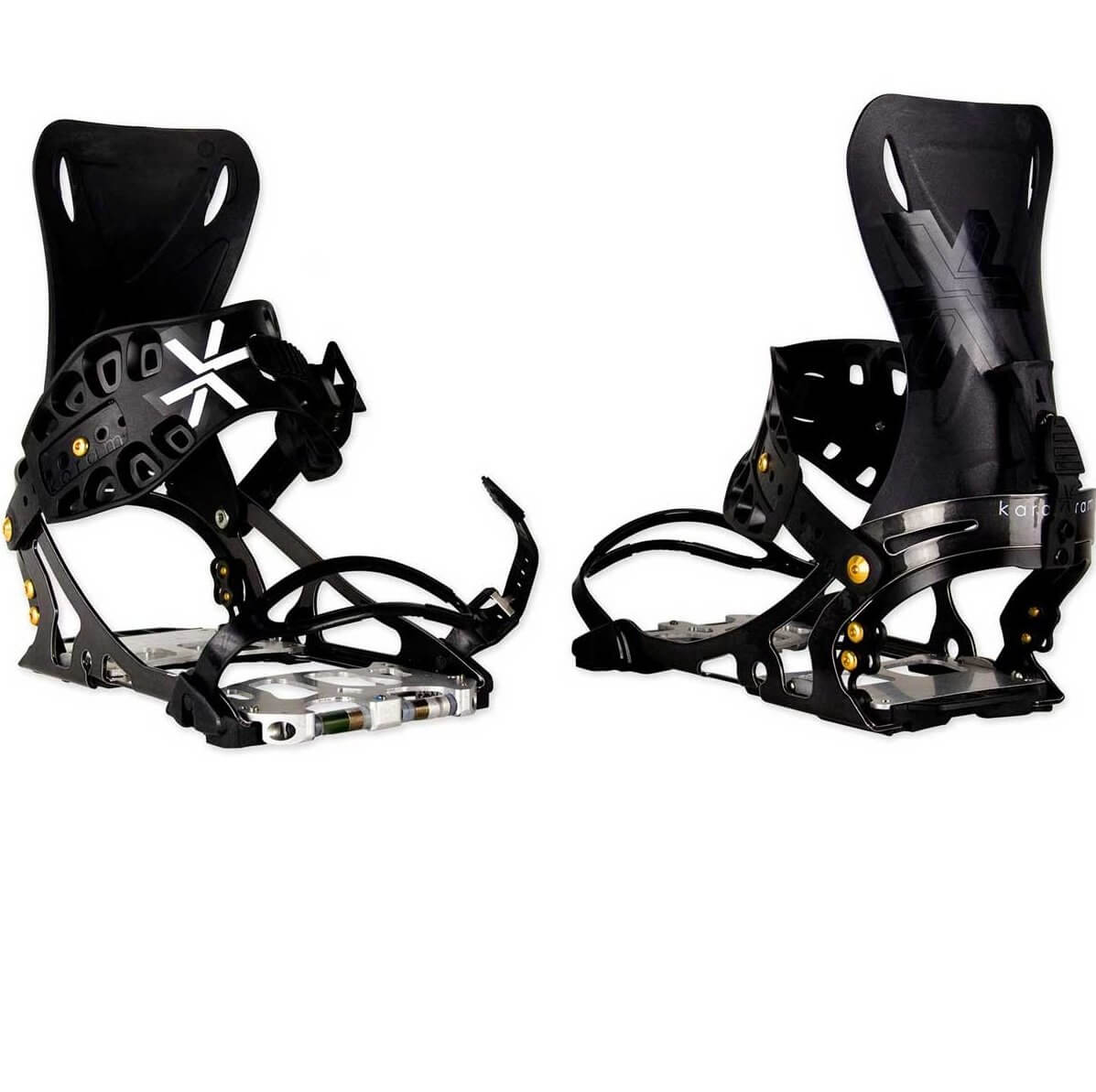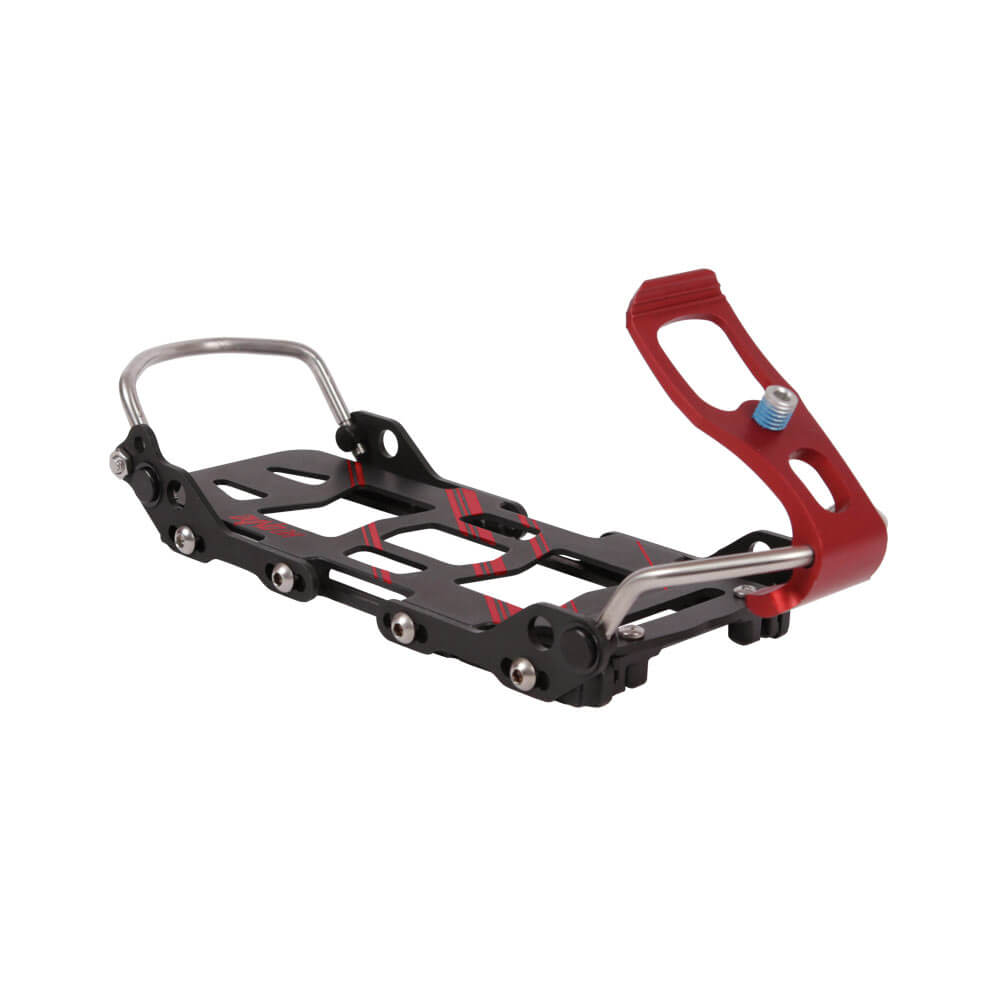Splitboard bindings are specifically designed for splitboard use. That may sound obvious, but there are several important design features in splitboard bindings that are worth having a closer look at, so you understand how they work together with your splitboard.
Splitboard Bindings
What are Splitboard Bindings?
Splitboard bindings each have their own interface, or “pucks,” which mount directly on the splitboard. The bindings slide onto these when you’re in board mode. The mounts not only act as another point locking the two halves of your splitboard together, they also secure the splitboard bindings to the board.
There is a separate set of binding hardware mounted on each half of the splitboard, when it is split into skis. The splitboard binding mounts in this hardware, and this is how the bindings pivot up and down as you ski your way up the mountain.
Also, since backcountry touring requires plenty of exertion as you climb, the bindings are designed to be lightweight, which saves energy as it’s less weight for you to move uphill.
You can pair any splitboard bindings with any splitboard.
What Kinds of Splitboard Bindings are There?
Soft Boot Binding
There are two main kinds of splitboard bindings: soft boot and hard boot. Soft boot bindings look like your typical resort bindings, and are designed to be used with snowboard boots. These are the overwhelming majority of bindings you'll see other people use. They are the simplest and most versatile.
Hard Boot Binding
The other major kind of splitboard binding are hard boot bindings. These are designed to be used with a ski boot and are only recommended for experienced backcountry splitboarders.
The idea behind using a ski boot is that they are stiffer than snowboard boots. Hard boot setups also tend to be lighter than their soft boot counterparts and are typically (with practice) quicker to transition between ride mode and ski mode. The stiffer boot setup makes for better touring performance, particularly when dealing with icy conditions where greater edge control is critical.
The ride mode does take some getting used to, and many hard boot riders do pretty major modifications to their boots to "soften" them to improve the ride feel. In our experience, backcountry snowboarders that gravitate towards hard boot setups are typically looking to do longer, more technical days in the mountains.
There are a variety of splitboard binding manufacturers, and although every binding may be designed a little different, they all accomplish the same thing. As splitboard bindings go up in price, what you’re paying for is increased stiffness and lighter weight.
How Do Splitboard Bindings Work?
First, you mount the binding hardware on your splitboard.
Then, when you split the splitboard into its two halves to climb up the mountain, the toe of the binding attaches to the board, and the heel is free to lift. This results in a similar mechanic as cross country skiing. The climbing skins grip the snow, and then you basically cross country ski up to your line.
Once you reach the start of your descent, you take your splitboard bindings off your board, then attach the two halves of the splitboard together. Then, you mount the splitboard on the pucks. At this point, your splitboard will look similar to your resort board. Step into your bindings, do them up, and then carve down the mountain just like you would on a snowboard!
Then, when it’s time to either climb back up for another lap, or ski back to your car, remove the bindings, separate your board, put your bindings back in ski mode, then cruise.
Pins vs No Pins
Pins Used in Sparq's Old Pin System
The way splitboard bindings attach to boards has changed.
Older tech is a pin system to fasten the binding to the board in both ride mode and ski mode.
This is simple, but easy to lose parts and create flex in the system. New tech is centred around pinless systems that are quicker, less failure prone, and perform better.
Can You Use Regular Bindings on a Splitboard?
Although splitboard bindings are built with backcountry use in mind, most manufacturers offer adapters that allow you to quickly and easily transfer your splitboard bindings from your splitboard to your resort board.
We have found this to be successful on the heavier versions of splitboard bindings. The softer, lighter weight ones tend not to stand up super well to the specific rigours of resort based snowboarding
Spark R&D Solid Board Flat Pucks

$105.00
Spark R&D Solid Board Flat Pucks have the quiver game dialed. Let's face it, sometimes you are just not on your split. Great for solid board mountaineering or snowmo-boarding. Perfect for trips where you are traveling with multiple boards or… Read More
Can I Try Different Snowboard Bindings?
AQ Outdoors and Splitboard HQ has gear rentals, so you can rent splitboard bindings when you're starting out, or try different bindings before purchase. Keep in mind that your rental fee can be used as credit toward a gear purchase.
We recommend proper avalanche training and splitboarding gear anytime you’re heading into the backcountry.
For avalanche course and backcountry trips, go here.
If you want to browse our products, check out the Splitboard Bindings Collection.
Other Splitboarding Articles
Do I Need Specific Boots for Splitboarding?
Detailed Splitboard Boot Features
Avalanche Safety Gear for Splitboarding
About the Authour: Dan used to instruct for AQ Outdoors and spent his 20s chasing whitewater up and down the Rockies and across Western Canada. He can still be found surfing local waves, trying to get some old moves back. If you are a mountain biker check out his site Hardtail Canada.
AQ Outdoors Contact
Edmonton: (p) 780 463-4892 (e) info@aquabaticsedmonton.com
Calgary: (p) 403 288-9283 (e) info@aqoutdoors.com

























































